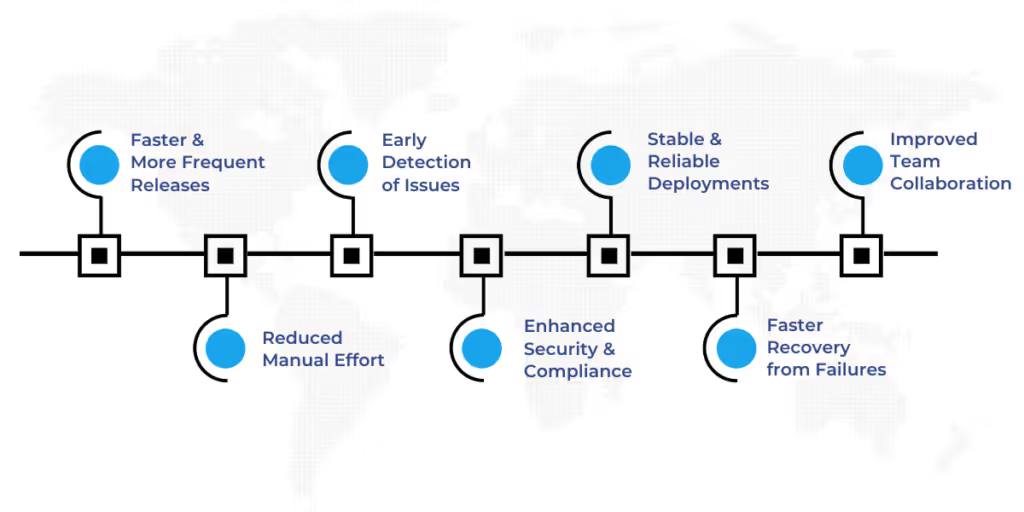

Deploying code should move a product forward but often brings development to a halt. Whether it’s a routine update or a major release, software deployment is meant to enhance functionality. However, sometimes, it can introduce failures that break key systems, forcing engineers to scramble for solutions. What should have been a smooth rollout quickly turns into an urgent rollback.
To prevent this, many teams adopt automation, expecting faster and safer releases. Yet, even with CI/CD in place, things still go wrong. Pipelines stall, deployments fail, and what was supposed to simplify workflows ends up feeling unpredictable. Why does this keep happening?
The issue isn’t just automation—it’s how it’s implemented. Without the right approach, a CI/CD pipeline can become another obstacle instead of an advantage. This blog breaks down what separates effective CI/CD from flawed workflows and the best practices that ensure reliability, speed, and stability.
CI/CD stands for Continuous Integration (CI) and Continuous Deployment/Delivery (CD)—a set of automation practices that improve how software is built, tested, and released. These practices help teams detect issues early, ensure code is always ready for deployment, and make releases more predictable.
CI ensures that new code changes are frequently merged, built, and tested in an automated workflow. Instead of waiting for long release cycles, developers commit small updates regularly, reducing the risk of integration failures.
CI keeps the codebase stable and prevents small issues from turning into large-scale failures.
The "CD" in CI/CD refers to the automated release process. The level of automation determines whether a team follows Continuous Delivery or Continuous Deployment.
Continuous Delivery ensures that every code change passes testing and is ready for deployment, but releases still require manual approval. This approach provides flexibility while maintaining stability.
Continuous Deployment takes it a step further by automating the entire release process. Once a change passes testing, it is immediately deployed to production without manual intervention. This method allows for rapid updates but requires strong monitoring and rollback strategies.
CI/CD removes the guesswork from software releases, making deployments more predictable. Teams can detect issues early and keep workflows efficient. But beyond automation, what real advantages does CI/CD bring? Let’s explore its key benefits.

Adopting CI/CD reshapes how teams develop and deploy software. It creates a structured, automated workflow that reduces risks and improves overall efficiency. Here are the key benefits of implementing CI/CD effectively.
CI/CD is a system that shapes how software moves from development to production. When implemented correctly, it ensures smooth deployments and reliable releases. Without optimal approaches, the process can become unpredictable, leading to failed builds and unnecessary delays
A well-structured CI/CD pipeline improves efficiency and minimizes risks, but achieving this requires the right approach. By following best practices, teams can build reliable workflows that support seamless integration and testing. Let’s look at the best practices that make CI/CD successful.
By following best practices, teams can maintain control over deployments and avoid unnecessary complications.
All code, configurations, and dependencies should be stored in a shared repository. Using version control systems like Git ensures that changes are tracked, reducing the risk of conflicts. Keeping everything centralized allows teams to work with the latest version without confusion.
Testing should be continuous, not an afterthought. Setting up automated unit, integration, and functional tests ensures early detection of defects. Using automation tools helps maintain software quality by identifying problems before deployment.
A slow pipeline disrupts development and delays releases. One way to improve efficiency is by running end-to-end tests selectively instead of on every commit. This reduces execution time while still ensuring reliability. Optimizing dependencies and adjusting resource allocation further streamline the process, allowing changes to move through the system without unnecessary slowdowns.
Security must be integrated into CI/CD rather than treated as a final checkpoint. Implementing automated security scans, dependency checks, and access control policies prevents vulnerabilities from reaching production. Tools like SAST, DAST, and container security scans can help identify risks early.
Deploying all changes at once increases risk. Using feature flags to control feature rollouts allows teams to release updates gradually. This makes it easier to test new functionalities in production and roll back changes instantly if issues arise.
Manual infrastructure management leads to inconsistencies and errors. Defining infrastructure as code with tools like Terraform, Ansible, or Kubernetes ensures that environments are reproducible and scalable. Automating provisioning eliminates configuration drift and deployment inconsistencies.
CI/CD doesn’t end after deployment. Integrating real-time monitoring and logging tools like Prometheus, ELK Stack, or Grafana helps track system performance. Automated alerts notify teams of issues before they impact users, allowing quick intervention.
Not everyone needs full access to the deployment pipeline. Implementing role-based access control (RBAC) ensures that only authorized team members can approve or modify releases. This reduces security risks and prevents accidental changes to production environments.
A consistent approach to branch naming, environment setup, and pipeline structure improves collaboration. Defining clear conventions for repository structures, commit messages, and CI/CD stages helps teams work more efficiently and avoid confusion.
Even with careful planning, failures happen. Setting up automated rollback mechanisms or maintaining stable release versions allows teams to revert changes instantly. Implementing blue-green or canary deployments ensures safer releases with minimal disruption.
Adopting these best practices transforms CI/CD from a simple automation tool into a reliable system that supports continuous innovation. With the right approach, teams can deploy new features, updates or fixes confidently, knowing their pipeline is built for success.
Mastering CI/CD best practices is essential for building a reliable DevOps pipeline. A well-structured workflow not only reduces failures but also ensures smooth and predictable deployments. Continuous testing and proactive monitoring help teams detect issues early, preventing minor errors from escalating into major disruptions. However, success depends on more than just automation. It requires a culture of collaboration, accountability, and a commitment to continuous improvement.
At WaferWire, we design CI/CD solutions that go beyond automation. Our approach focuses on creating resilient and scalable pipelines that support seamless deployments and long-term efficiency. From optimizing workflows to strengthening security, we help teams build systems they can trust.Unlock the full potential of CI/CD with a strategy built for success. Contact us today to implement a pipeline that drives results!

